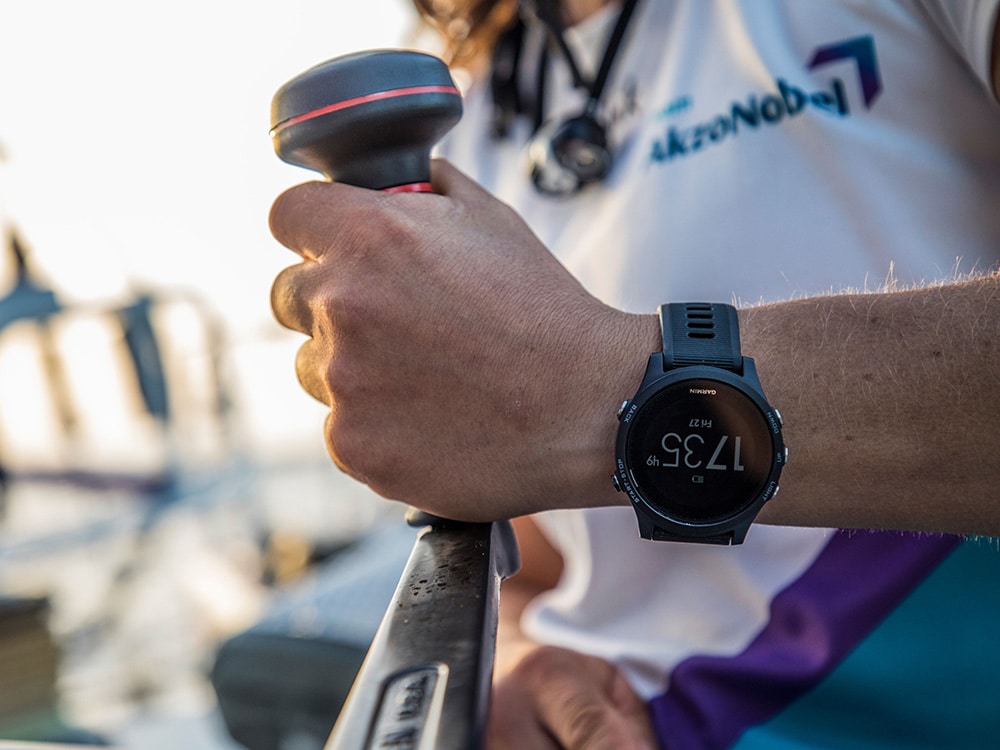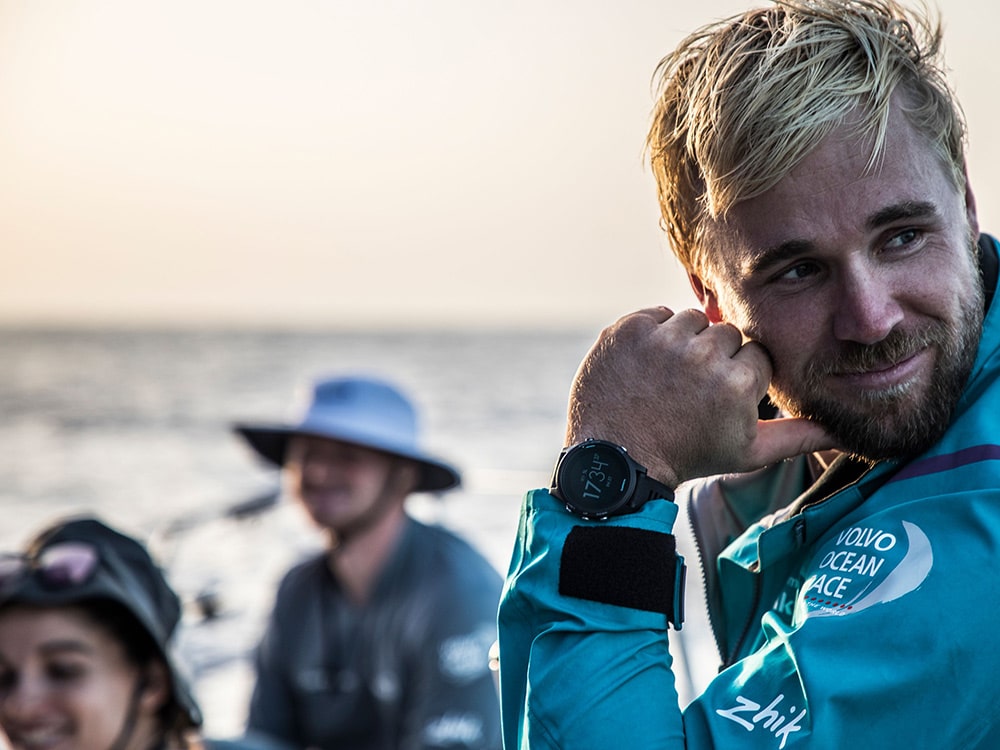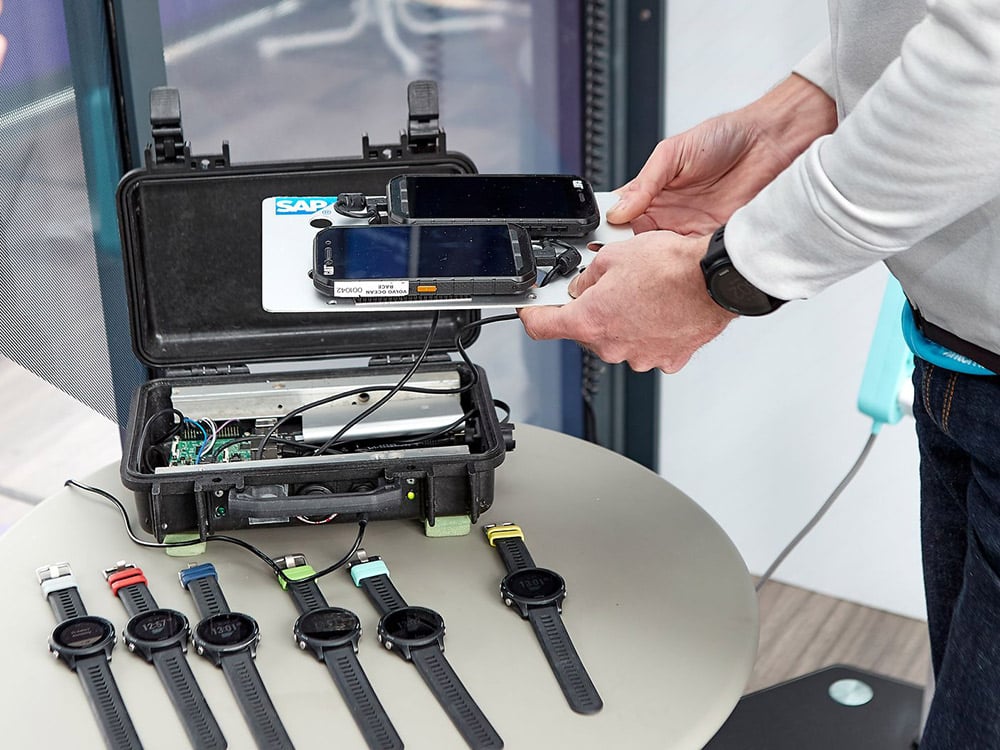
The boats are (essentially) the same, the sails identical, and the boatspeed differences at the front of the Volvo Ocean Race fleet are now close enough to be compared in decimals and single-digit percentages. Those decimals add up over thousands of miles of a leg, and it is — as any Volvo crew will attest — the incremental gains that will ultimately decide the finish order when the fleet pulls into The Hague in July.
In this age of big data, much is known of the performance of the Volvo 65, its sails and the complex method of moding the boat as conditions change by the hour at sea. Today, the boat is a measurable machine laden with sensors. Performance is now highly predictable. What it is not predictable, however, are the humans that propel it through highs and lows, storms and calms and hours of sleep and caloric deprivation. Consequently, the sailors on AkzoNobel, with support from the analytic wizards at technology giant SAP, have embarked on a game-changing effort to quantify the human X-factor. After eight grueling legs, the team is up to their neck gaiters in biometric data and they’re now grasping how predictive biometric modeling will translate directly to speed on the racecourse.
Ryan West, AkzoNobel’s performance manager, says predictive modeling is the key, and the team is early yet into the field. “We already measure trim, hull speed, angle, wind, and all of that, constantly running it through models,” he says. “We debrief after every leg and try and get faster, but we’re missing a huge component in this fleet — what’s different? The crew.”
West and his counterparts at SAP have implemented a biometric measurement program with the sailors, each of them wearing at all times offshore a Garmin Forerunner watch with an optic heartrate sensor.
“The biggest challenge was finding a device that is wearable the entire time they’re offshore,” say West. They tried chest straps, which provided good data, but was not ideal for the sailors. A wearable wrist device was the solution. A custom app on the Forerunner records heart-rate data every second while on deck and when the sailor goes below the unit automatically uploads the data to an encased Raspberry Pi. The Internet of Things computes sleep, caloric burn and provides athlete-specific, real-time data to the sailors themselves. Think of it as a personal wellness dashboard.

After a leg finish, SAP developers extract the data for a deeper dive, allowing the team to eventually compare and overlay sailor data over yacht data. “We are able to find trends that have never been seen,” says West. “The first couple of legs, simply capturing the data was a huge milestone. As far as we know, no one had gotten as much quality data offshore. The boat is its own environment and the humans act differently to it. Now we can take the environment and better understand how it will affect the sailors — before it happens.”
During a 21-day leg they can collect more than 18,000 (averaged) data points, allowing West to extrapolate daily caloric burn and individual sleep patterns. “The sailors can burn as many as 6,000 calories per day, so the more we can do to help them eat more efficiently, we can keep them at their optimum,” says West.
Disruptive sleep patterns take a toll on a sailor’s efficiency too. It’s the mental drain and the fog of four-hour watch rotations that slow maneuvers and inhibit rational decision making. Not surprisingly, West’s biometric analytics has revealed new understandings about off-watch efficiencies and what’s effecting sleep. “A lot of it is environmental,” he says.

Brad Farrand, AkzoNobel’s bowman, oversees the system on board the raceboat, and he too has a better understanding of his own traits. “I’ve learned much more about how many calories I’m actually burning and how environmental things effect sleep. For example, some bunks have more daylight than others and some guys don’t mind the light during the middle of the day, but others do.”
There are six different bunks, he adds, and each is unique when it comes to the movement of the boat. Heel angle, light, and even temperature make a big difference, says Farrand, who finds more restorative sleep from different bunks in different phases of the race. Modeling bunk preference is another tool, says West, that could make a significant impact as the sailors transition through time zones during the course of a leg.
“We’re on the cusp of — by next race — where with predictive modeling in the weather briefing in pre-leg we could be able to apply a human effect side as well,” says West. “Predicting which areas are most stressful on the crew.”
This is where the data modelers at SAP are working their magic, he says. “The more predictive we get the better we can start to look forward down the race track, applying the weather model, what the conditions will be, how they affect the sailors and how can they better adapt.”
What’s next? Perhaps integrating neurological elements to predict fatigue before it sets in, monitoring glucose levels, nutrient timing, hydration, status and many more. “Just like the yachts today have sensors all over the place, and you can see trend lines,” says West, “we could interpret how decisions are made and their outcomes based on diet and sleep.”









